2022 HYUNDAI I20 warning
[x] Cancel search: warningPage 50 of 444
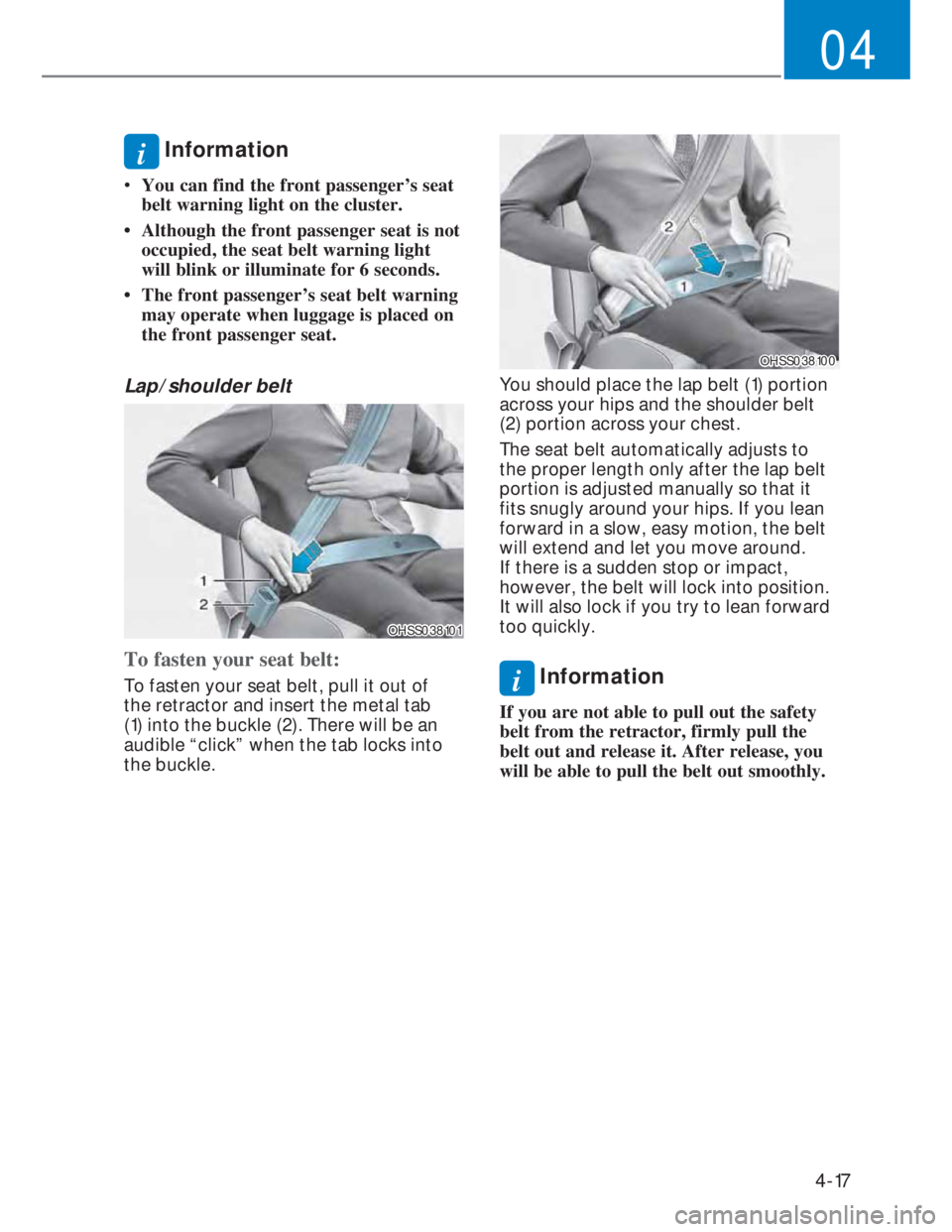
4-17
04
i Information
•You can find the front passenger’s seat
belt warning light on the cluster.
• Although the front passenger seat is not
occupied, the seat belt warning light
will blink or illuminate for 6 seconds.
• The front passenger’s seat belt warning
may operate when luggage is placed on
the front passenger seat.
Lap/shoulder belt
OHSS038101OHSS038101
To fasten your seat belt:
To fasten your seat belt, pull it out of
the retractor and insert the metal tab
(1) into the buckle (2). There will be an
audible “click” when the tab locks into
the buckle.
OHSS038100OHSS038100
You should place the lap belt (1) portion
across your hips and the shoulder belt
(2) portion across your chest.
The seat belt automatically adjusts to
the proper length only after the lap belt
portion is adjusted manually so that it
fits snugly around your hips. If you lean
forward in a slow, easy motion, the belt
will extend and let you move around.
If there is a sudden stop or impact,
however, the belt will lock into position.
It will also lock if you try to lean forward
too quickly.
i Information
If you are not able to pull out the safety
belt from the retractor, firmly pull the
belt out and release it. After release, you
will be able to pull the belt out smoothly.
Page 51 of 444
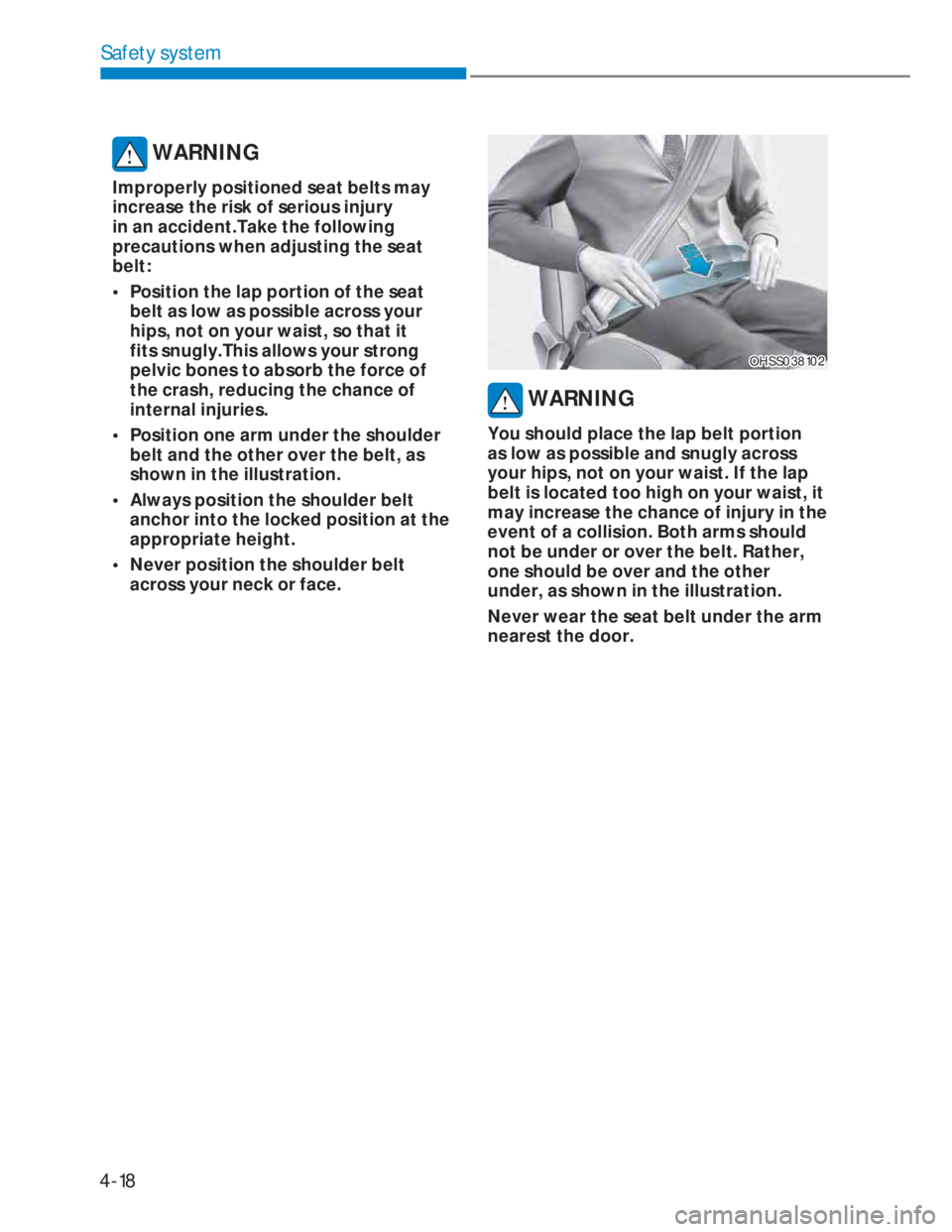
4-18
Safety system
WARNING
Improperly positioned seat belts may
increase the risk of serious injury
in an accident.Take the following
precautions when adjusting the seat
belt:
• Position the lap portion of the seat
belt as low as possible across your
hips, not on your waist, so that it
fits snugly.This allows your strong
pelvic bones to absorb the force of
the crash, reducing the chance of
internal injuries.
• Position one arm under the shoulder
belt and the other over the belt, as
shown in the illustration.
• Always position the shoulder belt
anchor into the locked position at the
appropriate height.
• Never position the shoulder belt
across your neck or face.
OHSS038102OHSS038102
WARNING
You should place the lap belt portion
as low as possible and snugly across
your hips, not on your waist. If the lap
belt is located too high on your waist, it
may increase the chance of injury in the
event of a collision. Both arms should
not be under or over the belt. Rather,
one should be over and the other
under, as shown in the illustration.
Never wear the seat belt under the arm
nearest the door.
Page 53 of 444
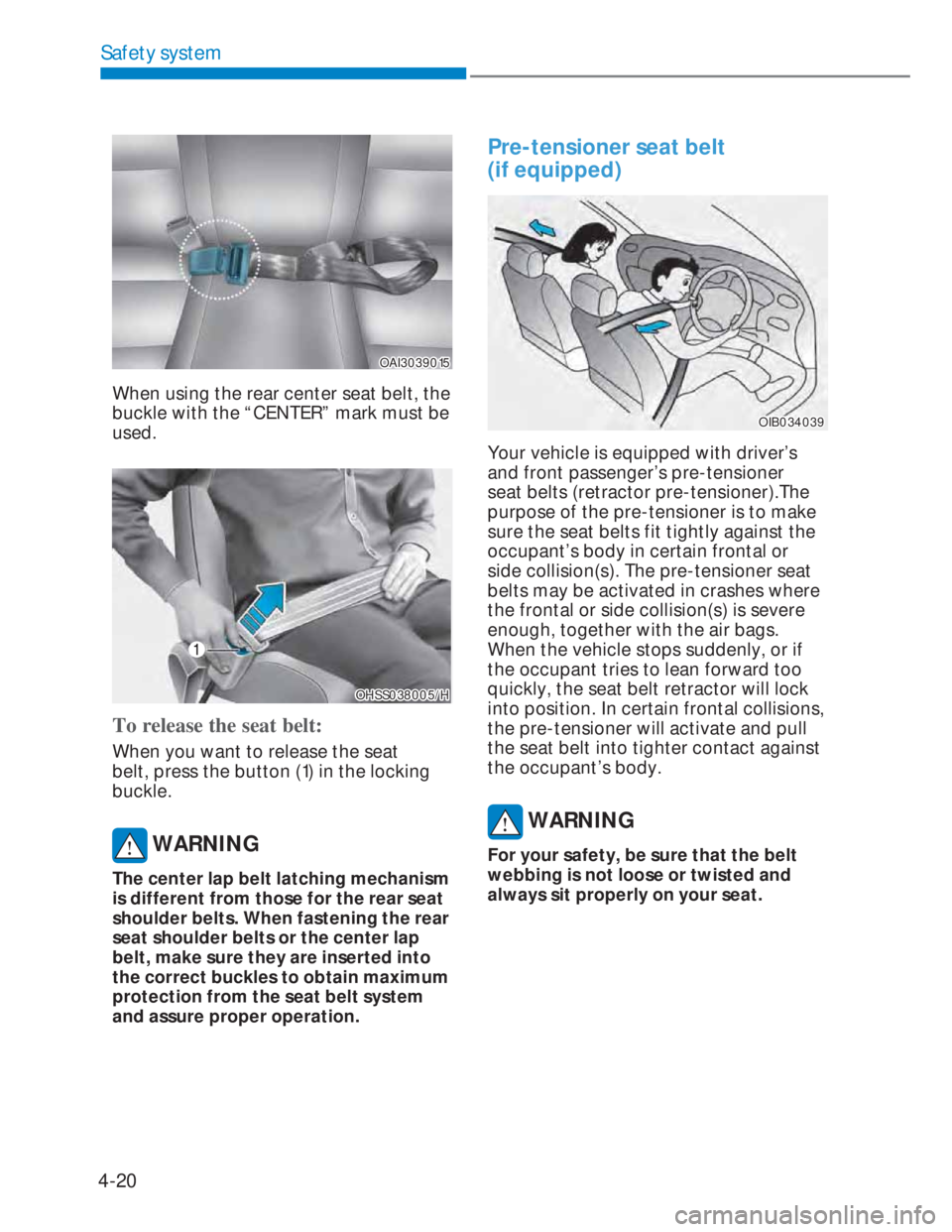
4-20
Safety system
OAI3039015OAI3039015
When using the rear center seat belt, the
buckle with the “CENTER” mark must be
used.
OHSS038005/HOHSS038005/H
To release the seat belt:
When you want to release the seat
belt, press the button (1) in the locking
buckle.
WARNING
The center lap belt latching mechanism
is different from those for the rear seat
shoulder belts. When fastening the rear
seat shoulder belts or the center lap
belt, make sure they are inserted into
the correct buckles to obtain maximum
protection from the seat belt system
and assure proper operation.
Pre-tensioner seat belt
(if equipped)
OIB034039OIB034039
Your vehicle is equipped with driver’s
and front passenger’s pre-tensioner
seat belts (retractor pre-tensioner).The
purpose of the pre-tensioner is to make
sure the seat belts fit tightly against the
occupant’s body in certain frontal or
side collision(s). The pre-tensioner seat
belts may be activated in crashes where
the frontal or side collision(s) is severe
enough, together with the air bags.
When the vehicle stops suddenly, or if
the occupant tries to lean forward too
quickly, the seat belt retractor will lock
into position. In certain frontal collisions,
the pre-tensioner will activate and pull
the seat belt into tighter contact against
the occupant’s body.
WARNING
For your safety, be sure that the belt
webbing is not loose or twisted and
always sit properly on your seat.
Page 54 of 444
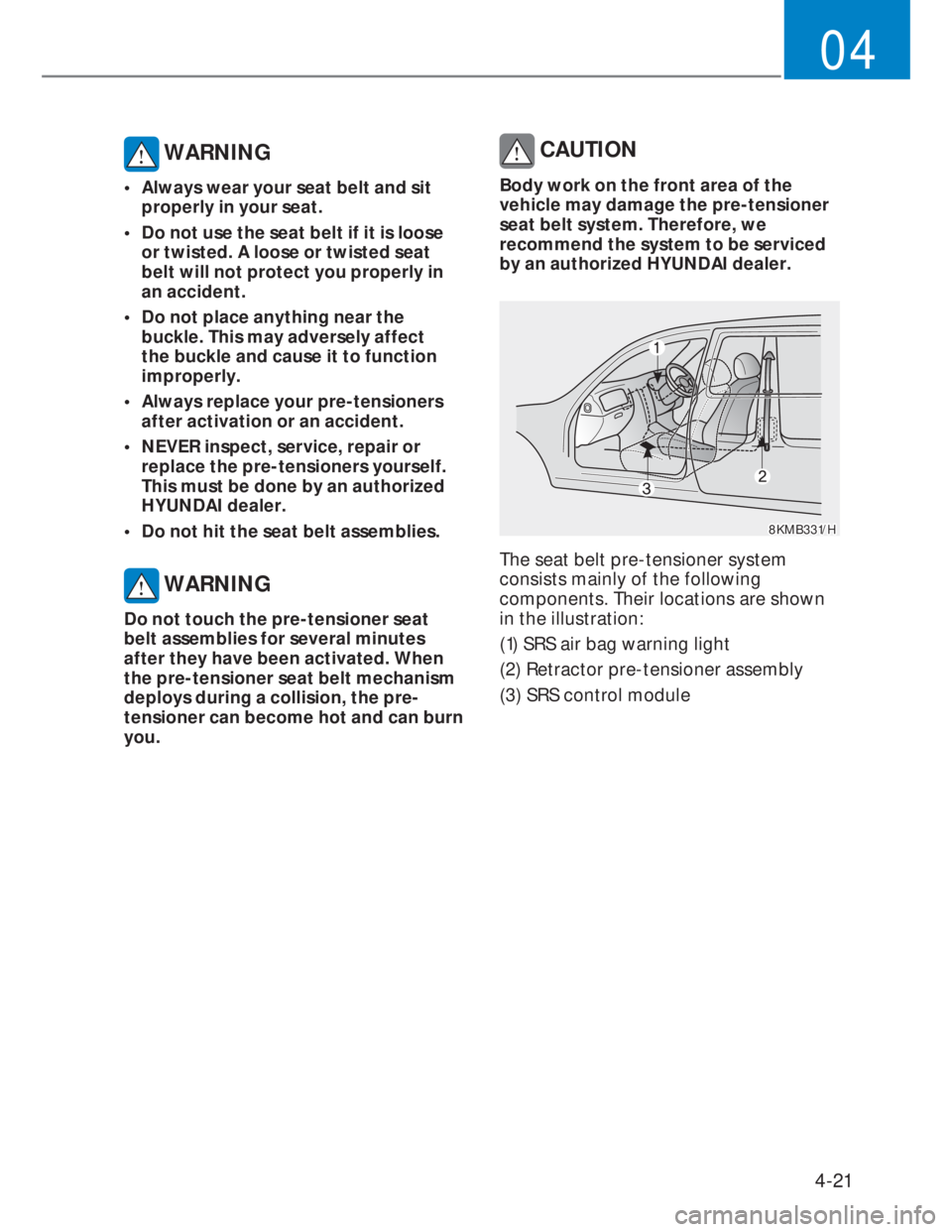
4-21
04
WARNING
• Always wear your seat belt and sit
properly in your seat.
• Do not use the seat belt if it is loose
or twisted. A loose or twisted seat
belt will not protect you properly in
an accident.
• Do not place anything near the
buckle. This may adversely affect
the buckle and cause it to function
improperly.
• Always replace your pre-tensioners
after activation or an accident.
• NEVER inspect, service, repair or
replace the pre-tensioners yourself.
This must be done by an authorized
HYUNDAI dealer.
• Do not hit the seat belt assemblies.
WARNING
Do not touch the pre-tensioner seat
belt assemblies for several minutes
after they have been activated. When
the pre-tensioner seat belt mechanism
deploys during a collision, the pre-
tensioner can become hot and can burn
you.
CAUTION
Body work on the front area of the
vehicle may damage the pre-tensioner
seat belt system. Therefore, we
recommend the system to be serviced
by an authorized HYUNDAI dealer.
8KMB331/H8KMB331/H
The seat belt pre-tensioner system
consists mainly of the following
components. Their locations are shown
in the illustration:
(1) SRS air bag warning light
(2) Retractor pre-tensioner assembly
(3) SRS control module
Page 55 of 444

4-22
Safety system
NOTICE
The sensor that activates the SRS
control module is connected with the
pre–tensioner seat belts. The SRS air
bag warning light on the instrument
cluster will illuminate for approximately
6 seconds after the ignition switch is
placed in the ON position, and then it
should turn off. If the pre-tensioner is
not working properly, the warning light
will illuminate even if the SRS air bag is
not malfunctioning. If the warning light
does not illuminate,stays illuminated
or illuminates when the vehicle is
being driven, we recommend the pre-
tensioner seat belts and/or SRS control
module be inspected by an authorized
HYUNDAI dealer as soon as possible.
i Information
• Both the driver’s and front passenger’s
pre-tensioner seat belts may be
activated in certain frontal or side
collisions.
• When the pre-tensioner seat belts are
activated, a loud noise may be heard
and fine dust, which may appear to be
smoke, may be visible in the passenger
compartment. These are normal
operating conditions and are not
hazardous.
• Although it is non-toxic, the fine dust
may cause skin irritation and should
not be inhaled for prolonged periods.
Wash all exposed skin areas thoroughly
after an accident in which the pre-
tensioner seat belts were activated.
Additional seat belt safety
precautions
Seat belt use during pregnancy
The seat belt should always be used
during pregnancy. The best way to
protect your unborn child is to protect
yourself by always wearing the seat
belt. Pregnant women should always
wear a lap-shoulder seat belt. Place the
shoulder belt across your chest, routed
between your breasts and away from
your neck. Place the lap belt below your
belly so that it fits SNUGLY across your
hips and pelvic bone, under the rounded
part of the belly.
WARNING
To reduce the risk of serious injury or
death to an unborn child during an
accident, pregnant women should
NEVER place the lap portion of the
seat belt above or over the area of the
abdomen where the unborn child is
located.
Seat belt use and children
Infant and small children
Most countries have Child Restraint
System laws which require children
to travel in approved Child Restraint
System devices, including booster seats.
The age at which seat belts can be
used instead of Child Restraint System
differs among countries, so you should
be aware of the specific requirements
in your country, and where you are
travelling. Infant and Child Restraint
System must be properly placed and
installed in a rear seat. For more details
refer to the “Child Restraint Systems”in
this chapter.
Page 56 of 444
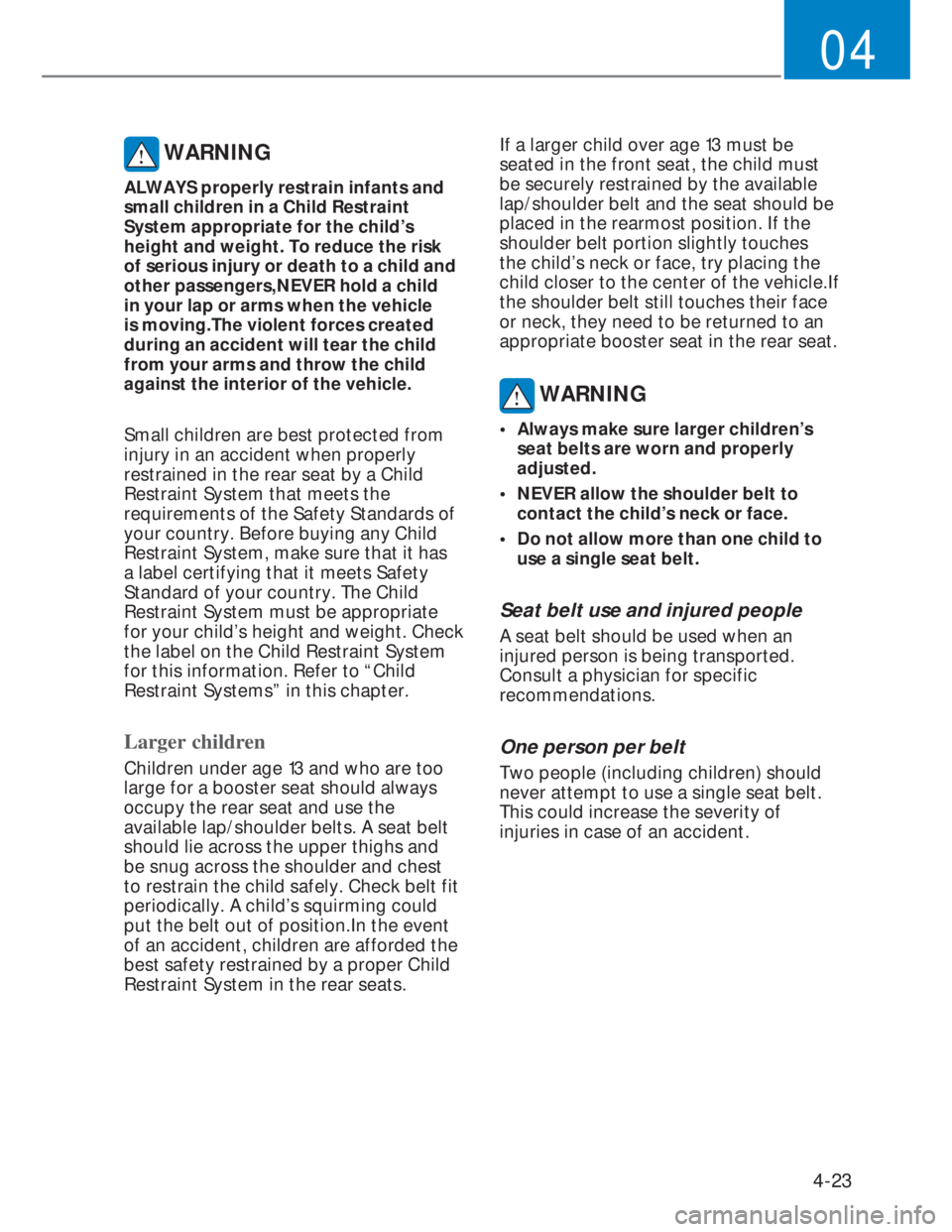
4-23
04
WARNING
ALWAYS properly restrain infants and
small children in a Child Restraint
System appropriate for the child’s
height and weight. To reduce the risk
of serious injury or death to a child and
other passengers,NEVER hold a child
in your lap or arms when the vehicle
is moving.The violent forces created
during an accident will tear the child
from your arms and throw the child
against the interior of the vehicle.
Small children are best protected from
injury in an accident when properly
restrained in the rear seat by a Child
Restraint System that meets the
requirements of the Safety Standards of
your country. Before buying any Child
Restraint System, make sure that it has
a label certifying that it meets Safety
Standard of your country. The Child
Restraint System must be appropriate
for your child’s height and weight. Check
the label on the Child Restraint System
for this information. Refer to “Child
Restraint Systems” in this chapter.
Larger children
Children under age 13 and who are too
large for a booster seat should always
occupy the rear seat and use the
available lap/shoulder belts. A seat belt
should lie across the upper thighs and
be snug across the shoulder and chest
to restrain the child safely. Check belt fit
periodically. A child’s squirming could
put the belt out of position.In the event
of an accident, children are afforded the
best safety restrained by a proper Child
Restraint System in the rear seats.If a larger child over age 13 must be
seated in the front seat, the child must
be securely restrained by the available
lap/shoulder belt and the seat should be
placed in the rearmost position. If the
shoulder belt portion slightly touches
the child’s neck or face, try placing the
child closer to the center of the vehicle.If
the shoulder belt still touches their face
or neck, they need to be returned to an
appropriate booster seat in the rear seat.
WARNING
• Always make sure larger children’s
seat belts are worn and properly
adjusted.
• NEVER allow the shoulder belt to
contact the child’s neck or face.
• Do not allow more than one child to
use a single seat belt.
Seat belt use and injured people
A seat belt should be used when an
injured person is being transported.
Consult a physician for specific
recommendations.
One person per belt
Two people (including children) should
never attempt to use a single seat belt.
This could increase the severity of
injuries in case of an accident.
Page 57 of 444
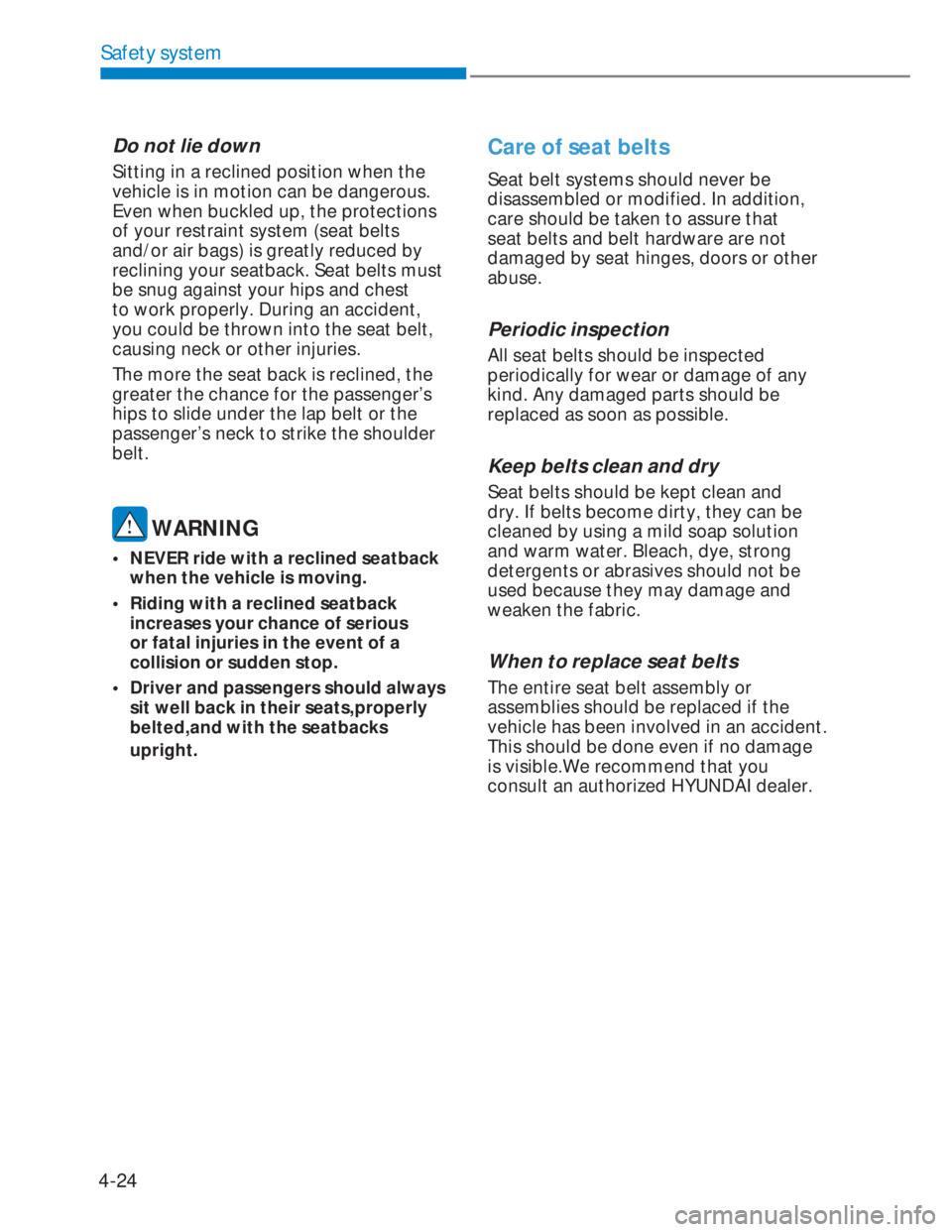
4-24
Safety system
Do not lie down
Sitting in a reclined position when the
vehicle is in motion can be dangerous.
Even when buckled up, the protections
of your restraint system (seat belts
and/or air bags) is greatly reduced by
reclining your seatback. Seat belts must
be snug against your hips and chest
to work properly. During an accident,
you could be thrown into the seat belt,
causing neck or other injuries.
The more the seat back is reclined, the
greater the chance for the passenger’s
hips to slide under the lap belt or the
passenger’s neck to strike the shoulder
belt.
WARNING
• NEVER ride with a reclined seatback
when the vehicle is moving.
• Riding with a reclined seatback
increases your chance of serious
or fatal injuries in the event of a
collision or sudden stop.
• Driver and passengers should always
sit well back in their seats,properly
belted,and with the seatbacks
upright.
Care of seat belts
Seat belt systems should never be
disassembled or modified. In addition,
care should be taken to assure that
seat belts and belt hardware are not
damaged by seat hinges, doors or other
abuse.
Periodic inspection
All seat belts should be inspected
periodically for wear or damage of any
kind. Any damaged parts should be
replaced as soon as possible.
Keep belts clean and dry
Seat belts should be kept clean and
dry. If belts become dirty, they can be
cleaned by using a mild soap solution
and warm water. Bleach, dye, strong
detergents or abrasives should not be
used because they may damage and
weaken the fabric.
When to replace seat belts
The entire seat belt assembly or
assemblies should be replaced if the
vehicle has been involved in an accident.
This should be done even if no damage
is visible.We recommend that you
consult an authorized HYUNDAI dealer.
Page 58 of 444
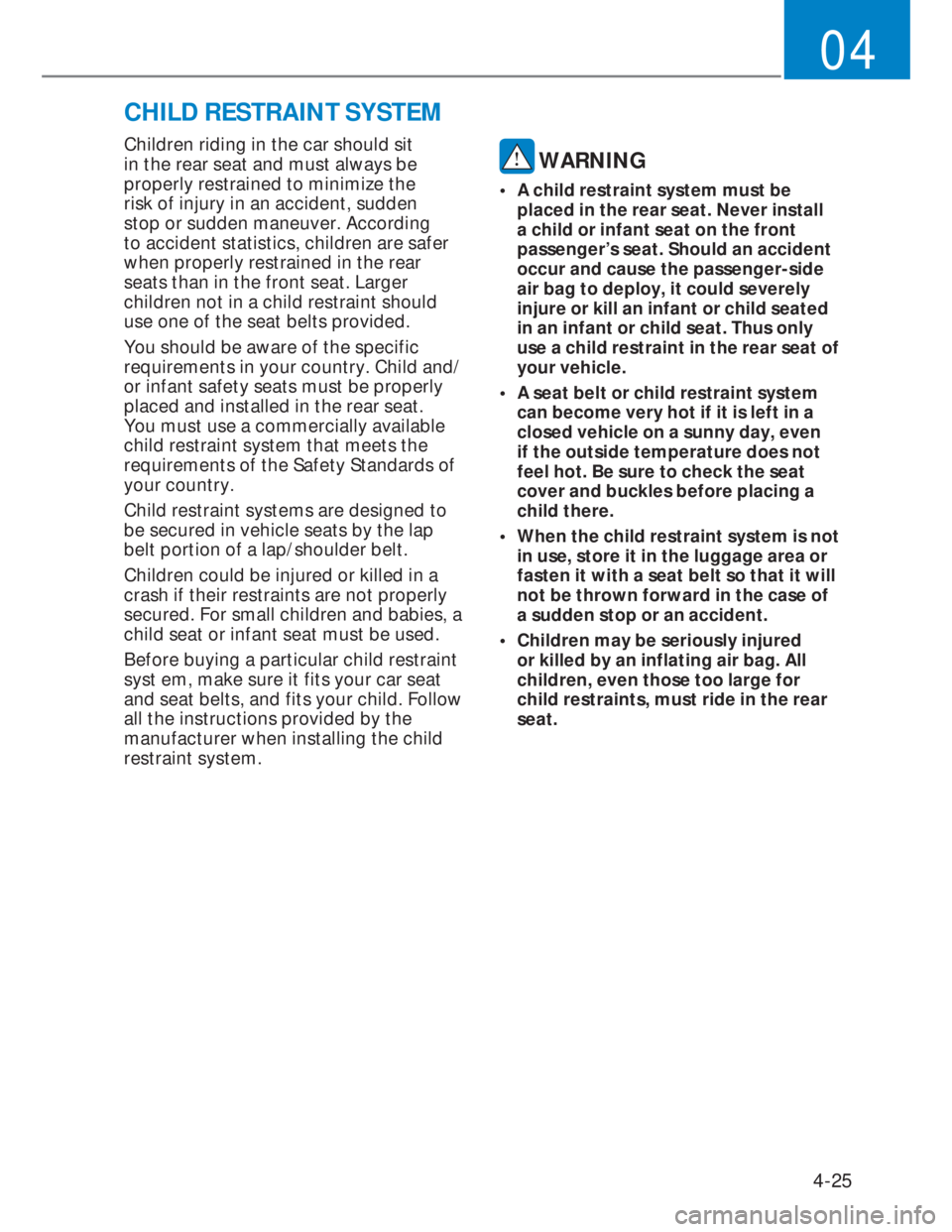
4-25
04
CHILD RESTRAINT SYSTEM
Children riding in the car should sit
in the rear seat and must always be
properly restrained to minimize the
risk of injury in an accident, sudden
stop or sudden maneuver. According
to accident statistics, children are safer
when properly restrained in the rear
seats than in the front seat. Larger
children not in a child restraint should
use one of the seat belts provided.
You should be aware of the specific
requirements in your country. Child and/
or infant safety seats must be properly
placed and installed in the rear seat.
You must use a commercially available
child restraint system that meets the
requirements of the Safety Standards of
your country.
Child restraint systems are designed to
be secured in vehicle seats by the lap
belt portion of a lap/shoulder belt.
Children could be injured or killed in a
crash if their restraints are not properly
secured. For small children and babies, a
child seat or infant seat must be used.
Before buying a particular child restraint
syst em, make sure it fits your car seat
and seat belts, and fits your child. Follow
all the instructions provided by the
manufacturer when installing the child
restraint system. WARNING
• A child restraint system must be
placed in the rear seat. Never install
a child or infant seat on the front
passenger’s seat. Should an accident
occur and cause the passenger-side
air bag to deploy, it could severely
injure or kill an infant or child seated
in an infant or child seat. Thus only
use a child restraint in the rear seat of
your vehicle.
• A seat belt or child restraint system
can become very hot if it is left in a
closed vehicle on a sunny day, even
if the outside temperature does not
feel hot. Be sure to check the seat
cover and buckles before placing a
child there.
• When the child restraint system is not
in use, store it in the luggage area or
fasten it with a seat belt so that it will
not be thrown forward in the case of
a sudden stop or an accident.
• Children may be seriously injured
or killed by an inflating air bag. All
children, even those too large for
child restraints, must ride in the rear
seat.